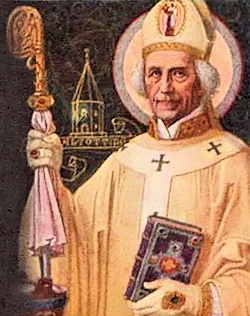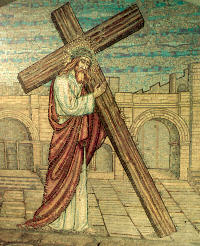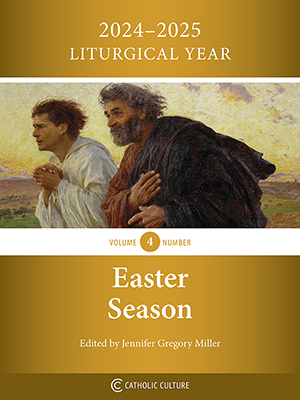Lent: March 27th
Saturday of the Fourth Week of Lent
Other Commemorations: St. Rupert, Bishop (RM)
» Enjoy our Liturgical Seasons series of e-books!
"We have been ransomed with the precious blood of Christ, as with the blood of a lamb without blemish of spot" (1 Pt 1:19). Mortification and self-denial are indispensable means of acquiring strength of will and virtuous habits, and of preserving the life of the soul.
Before the reform of the Roman Calendar this was the feast of St. John Damascene. His feast has been transferred to December 4.
This Saturday, in the early ages of Christianity, was called Sitientes, from the first word of the Introit of the Mass, in which the Church addresses her catechumens in the words of Isaias, and invites them that thirst after grace, to come and receive it in the holy Sacrament of Baptism. At Rome, the Station was originally in the basilica of Saint Lawrence outside the walls; but it was found inconvenient, on account of its great distance from the city; and the church of Saint Nicholas in carcere, which is within the walls, was selected for today's Station.
Meditation - God's Appeal to All the World
Pilate's "Ecce, Homo!" his appeal to the scornful multitude now on the point of breaking out into mob violence, was even more truly the mighty appeal of God's marvelous mercy to his chosen people and to all the human race.
"Behold the Man!" Behold the Lamb of God, the Son of the living God, in all these unsightly wounds, the most beautiful of men here disfigured beyond recognition, as one stricken by leprosy and all the other filthy diseases of mankind; yes, behold Him here, the most frightful symbol and demonstration of the monstrous evil of mortal sin ever to be given to the world; but even more, behold Him here, the clearest and the mightiest appeal of Heaven to all the world of souls to be converted and to rise from spiritual death to life, true and even divine.
"Behold the Man." O my soul, behold Christ Jesus there as the Lamb of God loaded with your own personal sins and bearing the ghastly wounds your sins inflicted on Him. Pray that you may recognize here, in this reed and purple and crown, God's very own caricature of your senseless pride, of the folly of your imaginary greatness. In that purple rag of a cloak see the sham honor and dignity in which your self-conceit and self-complacency clothe you! In that reed recognize the might of your strength in which you have been trusting. In that crown acknowledge the depth of humiliation you deserve for all your vanity and your open and secret envious ambition for recognition and authority and for honors and offices. O my soul, be honest enough to see and to acknowledge what a spectacle you are to all heaven in the light of the revelation in God's word: "Behold the Man!"
Yet again, "Behold the Man!" Look on Him that you may be filled with hope and courage. Let the crushing truth you have just been making your very own, serve to crush your nauseating and contaminating pride in all its open and especially its hitherto hidden forms. Behold the Man, the Lamb of God laden with your sins, but only to wash them away and to cast them into the deep sea of oblivion; yes, and even to take away your stony heart and give you a heart of flesh, to put His own spirit in your midst, and to cause you to walk in His commandments and to keep His judgments and to do them (Ezech. 36:26-30); in a word, to make a way in your wilderness, that shall be called "The Holy Way." (Isa. 35:6-8.) — Our Way to the Father by Rev. Leo M. Krenz, S.J.
St. Rupert of Salzburg
 St. Rupert was the first bishop of Salzburg, who, in some legends, is credited with giving the city its name.
St. Rupert was the first bishop of Salzburg, who, in some legends, is credited with giving the city its name.
Rupert was born in the late seventh century, to a part of the French imperial family. Little is known about his early life, but, like many sons of noblemen, entered the clergy. Rupert was elected bishop of Worms, a German city that was an important seat of power in the Carolingian dynasty.
At first, Rupert's flock welcomed his presence as a caring and faithful bishop. All too soon, however, the relationship between Rupert and the people of Worms soured. Conveniently, a Bavarian Duke, Theodo, asked for Rupert to come south to his palace at Regensburg to come spread Christianity to the diverse tribes he ruled over in Bavaria.
Rupert is often credited with baptizing Theodo, and officially welcoming him into the Church, as the seventeenth-century painting to the left depicts. And with Theodo's blessing, he began his missionary work among the Bavarian tribes.
Rupert found that Bavaria was still, in many ways, truly a wilderness with lots of outbreaks of violence. Thus, Rupert traveled to an old ruined Roman city and renamed it "Salzburg." Rupert founded and rebuilt several different monasteries in the area and lay the foundations of the Salzburg Cathedral. Where, a little over a thousand years later, Wolfgang Amadeus Mozart was baptized.
Rupert died in 710, and there's some dispute whether he had returned back to Worms at the time of his death or whether he died in Salzburg. His successor, Bishop Vergilius of Salzburg, interred his remains in the newly-finished Salzburg Cathedral in 774.
Rupert is known as the "Apostle to the Bavarians" and is a patron saint of Salzburg, Austria, and salt miners.
—Excerpted from Faith ND
Patronage: city of Salzburg, Austria; province of Salzburg, Austria; archdiocese of Salzburg; salt miners
Symbols and Representation: man holding a container of salt (refers to Salzburg and the salt mining there); wearing clerical clothes including mitre; holding a crosier
Highlights and Things to Do:
- Read more about St. Rupert:
- Read about St. Rupert's Fair, the biggest traditional fair in Europe.
- See the Stift St. Peter -- St. Peter's Abby that St. Rupert restored and lived.
- St. Rupert's remains are located at the Salzburg Cathedral at the Volksaltar.






